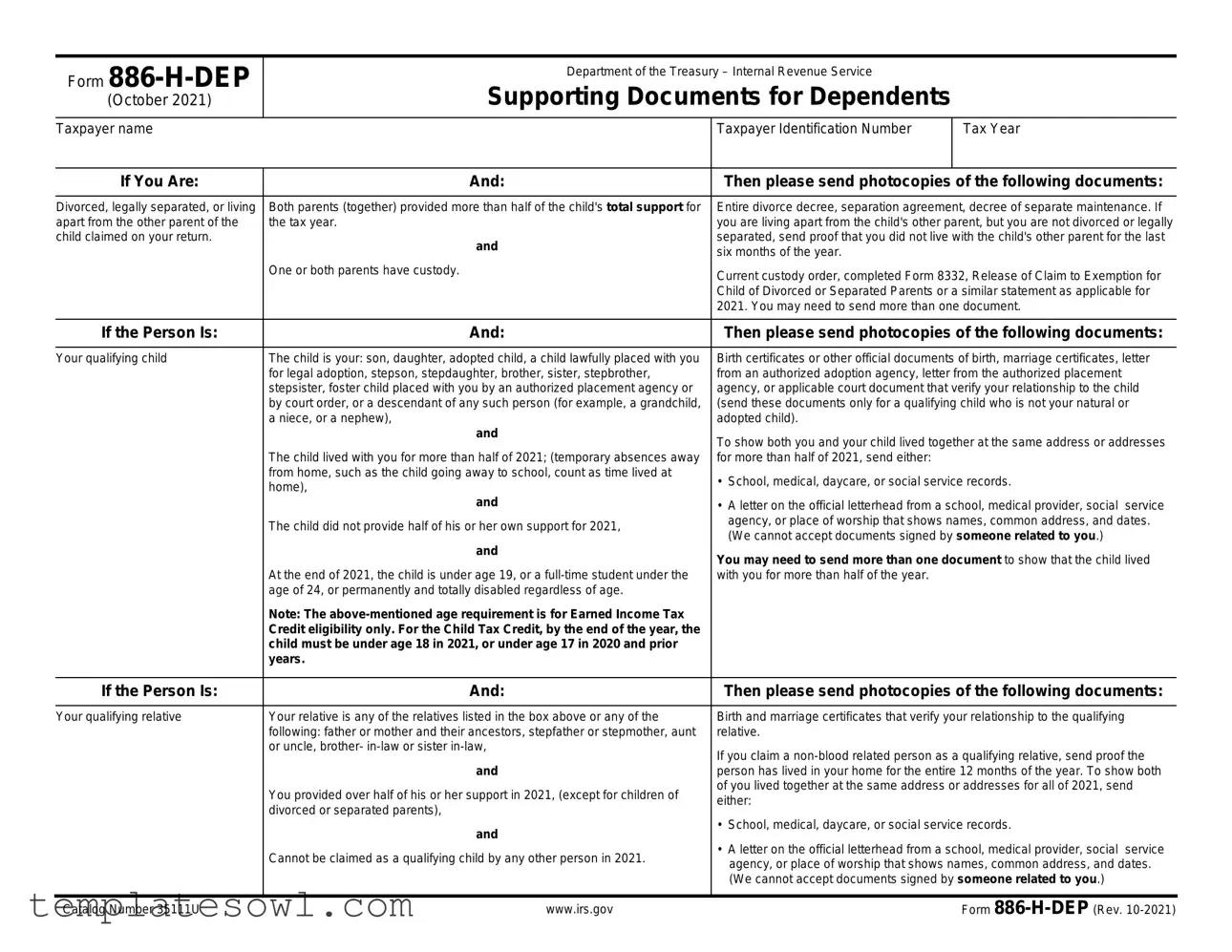If You Are: |
And: |
|
Then please send photocopies of the following documents: |
|
|
|
Divorced, legally separated, or living |
Both parents (together) provided more than half of the child's total support for |
Entire divorce decree, separation agreement, decree of separate maintenance. If |
apart from the other parent of the |
the tax year. |
you are living apart from the child's other parent, but you are not divorced or legally |
child claimed on your return. |
and |
separated, send proof that you did not live with the child's other parent for the last |
|
six months of the year. |
|
|
|
One or both parents have custody. |
Current custody order, completed Form 8332, Release of Claim to Exemption for |
|
|
|
|
Child of Divorced or Separated Parents or a similar statement as applicable for |
|
|
2021. You may need to send more than one document. |
|
|
|
|
If the Person Is: |
And: |
|
Then please send photocopies of the following documents: |
|
|
|
Your qualifying child |
The child is your: son, daughter, adopted child, a child lawfully placed with you |
Birth certificates or other official documents of birth, marriage certificates, letter |
|
for legal adoption, stepson, stepdaughter, brother, sister, stepbrother, |
from an authorized adoption agency, letter from the authorized placement |
|
stepsister, foster child placed with you by an authorized placement agency or |
agency, or applicable court document that verify your relationship to the child |
|
by court order, or a descendant of any such person (for example, a grandchild, |
(send these documents only for a qualifying child who is not your natural or |
|
a niece, or a nephew), |
adopted child). |
|
and |
To show both you and your child lived together at the same address or addresses |
|
|
|
The child lived with you for more than half of 2021; (temporary absences away |
for more than half of 2021, send either: |
|
from home, such as the child going away to school, count as time lived at |
• |
School, medical, daycare, or social service records. |
|
home), |
|
|
|
|
and |
• |
A letter on the official letterhead from a school, medical provider, social service |
|
The child did not provide half of his or her own support for 2021, |
|
agency, or place of worship that shows names, common address, and dates. |
|
|
(We cannot accept documents signed by someone related to you.) |
|
and |
|
|
You may need to send more than one document to show that the child lived |
|
At the end of 2021, the child is under age 19, or a full-time student under the |
|
with you for more than half of the year. |
|
age of 24, or permanently and totally disabled regardless of age. |
|
|
|
Note: The above-mentioned age requirement is for Earned Income Tax |
|
|
|
Credit eligibility only. For the Child Tax Credit, by the end of the year, the |
|
|
|
child must be under age 18 in 2021, or under age 17 in 2020 and prior |
|
|
|
years. |
|
|
|
|
|
|
If the Person Is: |
And: |
|
Then please send photocopies of the following documents: |
|
|
|
Your qualifying relative |
Your relative is any of the relatives listed in the box above or any of the |
Birth and marriage certificates that verify your relationship to the qualifying |
|
following: father or mother and their ancestors, stepfather or stepmother, aunt |
relative. |
|
or uncle, brother- in-law or sister in-law, |
If you claim a non-blood related person as a qualifying relative, send proof the |
|
and |
|
person has lived in your home for the entire 12 months of the year. To show both |
|
You provided over half of his or her support in 2021, (except for children of |
of you lived together at the same address or addresses for all of 2021, send |
|
either: |
|
divorced or separated parents), |
|
• |
School, medical, daycare, or social service records. |
|
and |
|
• |
A letter on the official letterhead from a school, medical provider, social service |
|
Cannot be claimed as a qualifying child by any other person in 2021. |
|
|
agency, or place of worship that shows names, common address, and dates. |
|
|
|
|
|
|
(We cannot accept documents signed by someone related to you.) |
|
|
|
|
Catalog Number 35111U |
www.irs.gov |
|
Form 886-H-DEP (Rev. 10-2021) |


